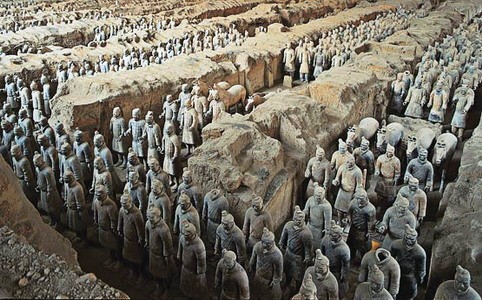Honey, I'm in over my head at work...
- A.French

- Jan 22, 2021
- 3 min read
Qin Shi Huang was China’s first emperor when he ascended the throne at the age of 13 and ordered work to start on his mausoleum. Major construction did not begin until shortly after he conquered the surrounding areas making what would then become a unified territory, China (named after him). It was built over 38 years by more than 700,000 conscripted labourers. The architecture of the mausoleum replicated the palace, but underground. It is said to have rivers of mercury that represented the Yangtze & Yellow River as well as the great sea. The tomb was filled with rare treasures and the bodies of his concubines who sacrificed themselves to be with their master in the afterlife. The emperor was interred and the ceremony was completed. The workers closed the inner passageway underground. It was soon realized that the workers would have had privy knowledge of the treasure that was buried. Without hesitation, the outer gate was closed and all the workers were trapped inside, buried alive. Photo: The Terracotta Army
Interesting notes:
Qin was the first emperor to unify China as a whole. The modern name of China is derived from Qin.
His tomb was like an underground recreation of a palace and well-planned city. It is under a mound that was approx. 120 meters high x 2167 meters across at the double wall base. It is half the height now due to erosion.
Mount Li was a favoured location due to its geography. It had jade mines in the south and the northern side had gold.
It is said that there were underground rivers that were simulated that flowed with mercury in the mausoleum and the ceiling was decorated with illustrations of heavenly bodies.
It was the largest tomb of its time and showcased the emperor's power. The underground palace was created so the soul could roam around. It was modelled after Xianyang and divided into inner and outer cities.
There were 5 streams that had to be diverted so they would not destroy the tomb.
Work began when Emperor Qin was 13 and eventually involved 700,000 workers. Constructed over 38 yrs, the 76-meter-tall tomb is shaped like a pyramid, there is a hill built on top of it.
Built the oldest parts of the Great Wall of China Connected parts of the pre-existing Wall of China to fend off barbarians of the north (Mongolians?)
There are over 8000 terracotta warriors that were individually crafted and unique. Life-sized and weighed about 300 – 400 lbs each. The terracotta army was to the east of the tomb mound and served as “protection” in the afterlife, facing towards the areas that were previously conquered. The Terracotta Army was to guard against the spirits of the victims.
There were also horses and chariots. Found buried around 7 main parts. There were also terracotta officials, acrobats and musicians.
The necropolis is a miniature replica of the Emperor's empire and palace. The tomb is in the centre with two walls (inner and outer) surrounding it. There are numerous pits inside and outside of the walls that contained figures and artifacts which included bronze chariots and horses, figurines of important courtiers and bureaucrats. Then terracotta figurines of entertainers, strongmen. Musicians and bronze swans and cranes on the outside of that. The terracotta army is located about 1.5 kms East of the tomb.
There is evidence to suggest that the underground palace had a very good drainage system (made from metal present)
The tomb is located SW of the inner city, facing east (note: Egypt also had East facing tombs as it was dawn)
The main tomb chamber held the coffin and funerary and was the main core of the complex.
Built mainly of slaves who were later killed or buried alive.
Built of rammed earth. Binding material that was made of dirt, sticky rice to bind the soil and rammed to get all the air out and so water could not penetrate it. It had the strength of concrete. Built-up in layers.
Interesting links:







Comments